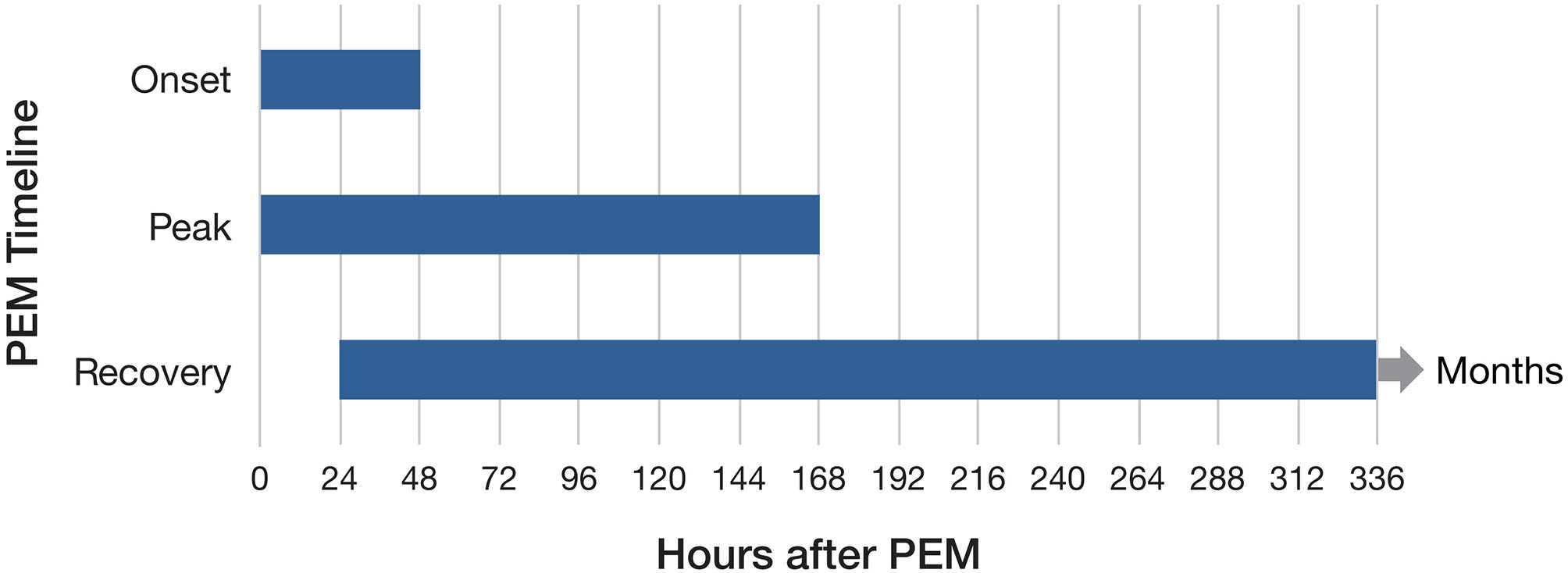|
Post-exertional Symptom Exacerbation
Post-exertional malaise (PEM), sometimes referred to as post-exertional symptom exacerbation (PESE) or post-exertional neuroimmune exhaustion (PENE), is a worsening of symptoms that occurs after minimal exertion. It is the hallmark symptom of myalgic encephalomyelitis/chronic fatigue syndrome (ME/CFS) and common in long COVID and fibromyalgia. PEM is often severe enough to be disabling, and is triggered by ordinary activities that healthy people tolerate. Typically, it begins 12–48 hours after the activity that triggers it, and lasts for days, but this is highly variable and may persist much longer. Management of PEM is symptom-based, and patients are recommended to Pacing (activity management), pace their activities to avoid triggering PEM. History and terminology One of the first definitions of ME/CFS, the Holmes Criteria published in 1988, does not use the term ''post-exertional malaise'' but describes prolonged fatigue after exercise as a symptom. The term was later used ... [...More Info...] [...Related Items...] OR: [Wikipedia] [Google] [Baidu] |
Myalgic Encephalomyelitis/Chronic Fatigue Syndrome
Myalgic encephalomyelitis/chronic fatigue syndrome (ME/CFS) is a disabling Chronic condition, chronic illness. People with ME/CFS experience profound fatigue that does not go away with rest, as well as sleep issues and problems with memory or concentration. The Pathognomonic, hallmark symptom is post-exertional malaise (PEM), a worsening of the illness which can start immediately or hours to days after even minor physical or mental activity. This "crash" can last from hours or days to several months. Further common symptoms include orthostatic intolerance, dizziness or faintness when upright and pain. The cause of the disease is unknown. ME/CFS often starts after an infection, such as infectious mononucleosis, mononucleosis. It can run in families, but no genes that contribute to ME/CFS have been confirmed. ME/CFS is associated with changes in the nervous and immune systems, as well as in energy production. Diagnosis is based on distinctive symptoms, and a differential diag ... [...More Info...] [...Related Items...] OR: [Wikipedia] [Google] [Baidu] |
Fatigue
Fatigue is a state of tiredness (which is not sleepiness), exhaustion or loss of energy. It is a signs and symptoms, symptom of any of various diseases; it is not a disease in itself. Fatigue (in the medical sense) is sometimes associated with medical conditions including autoimmune disease, organ failure, chronic pain conditions, mood disorders, heart disease, infectious diseases, and post-infectious-disease states. However, fatigue is complex and in up to a third of primary care cases no medical or psychiatric diagnosis is found. Fatigue (in the general usage sense of normal tiredness) often follows prolonged physical or mental activity. Physical fatigue results from muscle fatigue brought about by intense physical activity. Mental fatigue results from prolonged periods of Cognition, cognitive activity which impairs cognitive ability, can manifest as sleepiness, lethargy, or directed attention fatigue, and can also impair physical performance. Definition Fatigue in a medica ... [...More Info...] [...Related Items...] OR: [Wikipedia] [Google] [Baidu] |
Myalgic Encephalomyelitis/chronic Fatigue Syndrome
Myalgic encephalomyelitis/chronic fatigue syndrome (ME/CFS) is a disabling Chronic condition, chronic illness. People with ME/CFS experience profound fatigue that does not go away with rest, as well as sleep issues and problems with memory or concentration. The Pathognomonic, hallmark symptom is post-exertional malaise (PEM), a worsening of the illness which can start immediately or hours to days after even minor physical or mental activity. This "crash" can last from hours or days to several months. Further common symptoms include orthostatic intolerance, dizziness or faintness when upright and pain. The cause of the disease is unknown. ME/CFS often starts after an infection, such as infectious mononucleosis, mononucleosis. It can run in families, but no genes that contribute to ME/CFS have been confirmed. ME/CFS is associated with changes in the nervous and immune systems, as well as in energy production. Diagnosis is based on distinctive symptoms, and a differential diag ... [...More Info...] [...Related Items...] OR: [Wikipedia] [Google] [Baidu] |
Physical Therapy
Physical therapy (PT), also known as physiotherapy, is a healthcare profession, as well as the care provided by physical therapists who promote, maintain, or restore health through patient education, physical intervention, disease prevention, and health promotion. Physical therapist is the term used for such professionals in the United States, and physiotherapist is the term used in many other countries. The career has many specialties including musculoskeletal, orthopedics, cardiopulmonary, neurology, endocrinology, sports medicine, geriatrics, pediatrics, women's health, wound care and electromyography. PTs practice in many settings, both public and private. In addition to clinical practice, other aspects of physical therapy practice include research, education, consultation, and health administration. Physical therapy is provided as a primary care treatment or alongside, or in conjunction with, other medical services. In some jurisdictions, such as the United Kin ... [...More Info...] [...Related Items...] OR: [Wikipedia] [Google] [Baidu] |
Cardinal Sign (pathology)
Signs and symptoms are diagnostic indications of an illness, injury, or condition. Signs are objective and externally observable; symptoms are a person's reported subjective experiences. A sign for example may be a higher or lower temperature than normal, raised or lowered blood pressure or an abnormality showing on a medical scan. A symptom is something out of the ordinary that is experienced by an individual such as feeling feverish, a headache or other pains in the body, which occur as the body's immune system fights off an infection. Signs and symptoms Signs A medical sign is an objective observable indication of a disease, injury, or medical condition that may be detected during a physical examination. These signs may be visible, such as a rash or bruise, or otherwise detectable such as by using a stethoscope or taking blood pressure. Medical signs, along with symptoms, help in forming a diagnosis. Some examples of signs are nail clubbing of either the fingernails or to ... [...More Info...] [...Related Items...] OR: [Wikipedia] [Google] [Baidu] |
2-day CPET
A 2-day CPET is a cardiopulmonary exercise test given on two successive days to measure the effect of post-exertional malaise (PEM) on a patient's ability to exercise. PEM is a cardinal symptom of myalgic encephalomyelitis/chronic fatigue syndrome and is common in long COVID as well. Background Several differences have been found between people with and without ME/CFS, including people with other diseases or who are sedentary. On the first test, people with ME/CFS exhibit lower performance and heart rate, and on the second test, performance is even lower, while for controls, it is the same or slightly better. The largest decrease is in anaerobic threshold, which signifies a shift from aerobic to anaerobic metabolism at a lower level of exertion, and is not influenced by effort. Peak power output, heart rate, and VO2max also decrease, and in ME/CFS, but effort and familiarity with the test may affect VO2max and power. Additionally, healthy people generally recover from a CPET ... [...More Info...] [...Related Items...] OR: [Wikipedia] [Google] [Baidu] |
Journal Of Internal Medicine
The ''Journal of Internal Medicine'' is a monthly peer-reviewed medical journal covering all aspects of internal medicine. It was established in 1863 and is published by Wiley-Blackwell on behalf of the Association for the Publication of the Journal of Internal Medicine. The editor-in-chief is Bo Angelin (Karolinska Institute). History The journal was established in 1863 as ''Medicinskt Archiv'' by Axel Key (Karolinska Institute). It covered the broad field of medicine, but accepted only contributions from Sweden written in Swedish. However, it soon became more international and in 1869 it was renamed ''Nordiskt Medicinskt Arkiv'', accepting articles from all Nordic countries in Swedish, Danish, and Norwegian, with abstracts in German. In 1901, the journal was divided into two sections, one for internal medicine and one for surgery. The two parts were in 1919 fully separated into ''Acta Medica Scandinavica'' and ''Acta Chirurgica Scandinavica''. ''Acta Medica Scandinavica'' cove ... [...More Info...] [...Related Items...] OR: [Wikipedia] [Google] [Baidu] |
Sleep Deprivation
Sleep deprivation, also known as sleep insufficiency or sleeplessness, is the condition of not having adequate duration and/or quality of sleep to support decent alertness, performance, and health. It can be either Chronic (medicine), chronic or Acute (medicine), acute and may vary widely in severity. All known animals sleep or exhibit some form of sleep behavior, and the importance of sleep is self-evident for humans, as nearly a third of a person's life is spent sleeping. Sleep deprivation is common as it affects about one-third of the population. The National Sleep Foundation recommends that adults aim for 7–9 hours of sleep per night, while children and teenagers require even more. For healthy individuals with normal sleep, the appropriate sleep duration for school-aged children is between 9 and 11 hours. Acute sleep deprivation occurs when a person sleeps less than usual or does not sleep at all for a short period, typically lasting one to two days. However, if the slee ... [...More Info...] [...Related Items...] OR: [Wikipedia] [Google] [Baidu] |
Insomnia
Insomnia, also known as sleeplessness, is a sleep disorder where people have difficulty sleeping. They may have difficulty falling asleep, or staying asleep for as long as desired. Insomnia is typically followed by daytime sleepiness, low energy, irritability, and a depression (mood), depressed mood. It may result in an increased risk of accidents of all kinds as well as problems focusing and learning. Insomnia can be short term, lasting for days or weeks, or long term, lasting more than a month. The concept of the word ''insomnia'' has two distinct possibilities: insomnia disorder (ID) or insomnia symptoms, and many abstracts of randomized controlled trials and systematic reviews often underreport on which of these two possibilities the word refers to. Insomnia can occur independently or as a result of another problem. Conditions that can result in insomnia include psychological stress, chronic pain, heart failure, hyperthyroidism, heartburn, restless leg syndrome, menopause ... [...More Info...] [...Related Items...] OR: [Wikipedia] [Google] [Baidu] |
Cognitive Deficit
Cognitive impairment is an inclusive term to describe any characteristic that acts as a barrier to the cognition process or different areas of cognition. Cognition, also known as cognitive function, refers to the mental processes of how a person gains knowledge, uses existing knowledge, and understands things that are happening around them using their thoughts and senses. Cognitive impairment can be in different domains or aspects of a person's cognitive function including memory, attention span, planning, reasoning, decision-making, language (comprehension, writing, speech), executive functioning, and visuospatial functioning. The term cognitive impairment covers many different diseases and conditions and may also be symptom or manifestation of a different underlying condition. Examples include impairments in overall intelligence (as with intellectual disabilities), specific and restricted impairments in cognitive abilities (such as in learning disorders like dyslexia), neuropsyc ... [...More Info...] [...Related Items...] OR: [Wikipedia] [Google] [Baidu] |
Stressor
A stressor is a chemical or biological agent, environmental condition, external stimulus or an event seen as causing stress to an organism. Psychologically speaking, a stressor can be events or environments that individuals might consider demanding, challenging, and/or threatening individual safety.Deckers, Lambert (2018). Motivation Biological, Psychological, and Environmental. New York, NY: Routledge. pp. 208-212. . Events or objects that may trigger a stress response may include: * environmental stressors ( hypo or hyper-thermic temperatures, elevated sound levels, over-illumination, overcrowding) * daily "stress" events (e.g., traffic, lost keys, money, quality and quantity of physical activity) * life changes (e.g., divorce, bereavement) * workplace stressors (e.g., high job demand vs. low job control, repeated or sustained exertions, forceful exertions, extreme postures, office clutter) * chemical stressors (e.g., tobacco, alcohol, drugs) * social stressors (e.g., soc ... [...More Info...] [...Related Items...] OR: [Wikipedia] [Google] [Baidu] |


